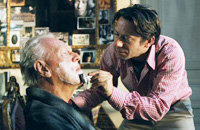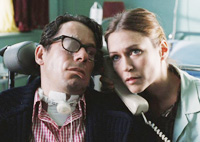The Diving Bell and the Butterfly
by Siegfried Othmer | December 31st, 2007 We have just seen the new movie, The Diving Bell and the Butterfly, which opened here recently in limited release. I had read the book some years ago because of its graphic telling of the story of locked-in syndrome. Jean-Dominique Bauby, editor of the French edition of Elle, had a brainstem stroke that left him entirely paralyzed except for movement in one eye. The other eye, bereft of episodic lavage, is sewn shut as he rages inside, unable to object.
We have just seen the new movie, The Diving Bell and the Butterfly, which opened here recently in limited release. I had read the book some years ago because of its graphic telling of the story of locked-in syndrome. Jean-Dominique Bauby, editor of the French edition of Elle, had a brainstem stroke that left him entirely paralyzed except for movement in one eye. The other eye, bereft of episodic lavage, is sewn shut as he rages inside, unable to object.
Initially I could not imagine how this story could be made into a movie. My point of comparison was the movie made of Dalton Trumbo’s book, “Johnny Got His Gun,” which is an ordeal to watch. A couple of favorable reviews overcame my natural resistance, and we were very much rewarded. A story like this must be told with some humor mixed in, and this one does so. The ham-fistedness of the French doctors; the friends who can’t find the right words to say; the fly that lands on his nose. Then there is the steadfastness and earnestness of the therapists, affronted when he tells them that he wishes simply to die. And there is the poignancy of the call from his mistress while the mother of his children is sitting in the room tending to him, and of the flashback to his giving his aging father a shave.


He is taught to communicate with his eye, letter by letter with the help of a spoken alphabet, and by these means he ends up fulfilling a book contract, albeit with a different theme than he had originally intended. Bauby would construct and memorize the text during his hours of solitude, and then pour the contents out one letter at a time to his scribe. The Diving Bell (his frozen body) and the Butterfly (his imagination) is the result. Bauby died on March 7th of 2007. Communication was a tie back into the flow of life, but perhaps in the end it was not enough to keep him going.
 I had a whole-body PET scan the other day, and since this occurred just the day after seeing the movie I could not help but identify with Bauby in my two hours of enforced stillness. Two hours were quite enough. At first there is the infusion of the radioactive glucose, which then piles up in those regions that consume the most glucose. I had not been given any explicit instructions with respect to maintaining stillness throughout, but it was clear to me that any muscle movement would consume glucose and was therefore to be avoided. It would result in a loss of contrast in the PET scan when there may be precious little contrast in the first place.
I had a whole-body PET scan the other day, and since this occurred just the day after seeing the movie I could not help but identify with Bauby in my two hours of enforced stillness. Two hours were quite enough. At first there is the infusion of the radioactive glucose, which then piles up in those regions that consume the most glucose. I had not been given any explicit instructions with respect to maintaining stillness throughout, but it was clear to me that any muscle movement would consume glucose and was therefore to be avoided. It would result in a loss of contrast in the PET scan when there may be precious little contrast in the first place.
And once you are sent through the PET scanner, the crispness of the images also depends on one’s bodily stillness, although once again no explicit instructions had been given except to “keep your hands at your side.” The exposure time for each sample was 7.5 minutes. So for a couple of hours I was lying there making like a mummy, and contemplating the fate of Jean-Dominique Bauby. It was not a good replication, of course, because I knew my enforced stillness was not only voluntary but also quite temporary.
This movie is about as close as we are likely to get to the full story of locked-in syndrome, in which not even an eye muscle is available for action. Bauby’s erstwhile masculine good looks had by now been distorted with a badly protruding wayward lower lip, but one could still sate the camera with that madly roving eye bearing fear specifically and emotional intensity in general.
So one must simply translate this movie mentally to the situation of Niels Birbaumer and his staff tending to fully locked-in patients who are restricted to communicating with the outside world entirely via control of their own EEGs. For these patients, the ability to communicate is clearly a life preserver. “They do not die,” says Birbaumer. And they tell his staff that their perceived quality of life is actually higher than what is reported by their immediate family members!
Quite simply a movie to see.





